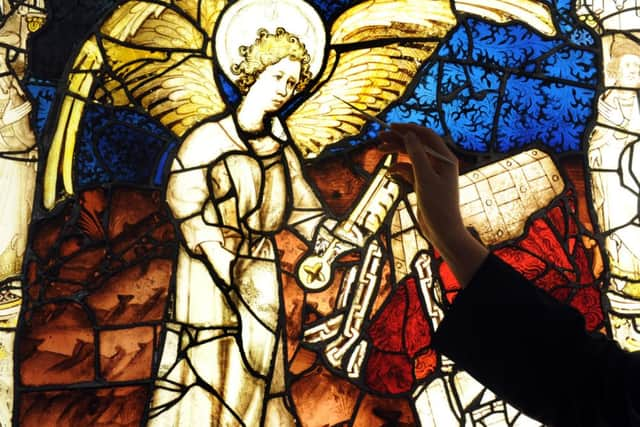Minster treasure given a hi-tech sunscreen


The cathedral is understood to be the first building in the country to use a new UV-resistant glass as part of the external protective glazing for the 15th century window, designed and created by medieval artist John Thornton over three years from 1405 to 1408.
Stained glass from the window has been removed and is being painstakingly conserved by York Glaziers Trust.
Advertisement
Hide AdAdvertisement
Hide AdThe work to conserve and restore the great east window is part of the York Minster Revealed project which is due for completion in 2016.


“We are delighted to be at the forefront of this new cutting-edge technological advance, which represents a wise investment in the long term care of the building,” said York Minster Revealed director Mark Hosea yesterday.
Previous protective glazing has acted as a weather shield and kept glass, pigments, lead and conservation materials dry, but has not been an adequate barrier to ultraviolet radiation, which can affect any epoxy resin used in the conservation of the stained glass and eventually lead to discolouration.
Earlier forms of UV-resistant glass have relied on lamination and a UV-resistant foil, but in the new glass, the UV resistance is an integral part of the glass itself. The product has been developed by Glasshuette Lamberts of Germany, who otherwise make mouth-blown glass in an antique style.
Advertisement
Hide AdAdvertisement
Hide AdYork Glaziers Trust director Sarah Brown said: “It is reassuring to know that we are now able to offer total environmental protection for all aspects of the conserved window.


“Each panel is in itself a priceless work of art, painted with the skills of a Van Eyck or a Vermeer.”
At 78ft (27.7 metres) tall and roughly the size of a tennis court, the 311 panels of the great east window make it the largest expanse of medieval stained glass in the UK. It is regarded as one of the greatest pre-Renaissance treasures of European art.
Depicting the beginning and end of all things, from the Book of Genesis to the Book of Revelation, in unrivalled scale, detail and colour, the beguiling window has attracted visitors for more than 600 years.
Advertisement
Hide AdAdvertisement
Hide AdMuch needed work to conserve panels on the great east window is part of a £20m project, which is backed by the Yorkshire Post and supported by a £10.5m grant from the Heritage Lottery Fund.
The five-year project is one of the largest restoration and conservation projects of its kind in Europe.
Each panel in the window is considered by many to be an unappreciated masterpiece.
The designer, John Thornton, is widely regarded as an unsung hero of English art, with some commentators describing the master craftsman as the English equivalent of Vermeer or Michelangelo.
Advertisement
Hide AdAdvertisement
Hide AdThornton was a Coventry artist specialising in stained glass who built his reputation in the great medieval city of churches and monasteries.
In 1405, he was invited to York to complete the great east window project.
A 17th century copy of the contract he signed is still held in the York Minster archives, detailing he was to be paid £56 for his work.
It is also known that he received a £10 bonus for completing the assignment on time.
Advertisement
Hide AdAdvertisement
Hide AdThe masterpiece was created to add colour and drama to the eastern wing of the great gothic cathedral and to celebrate the glory of God.
Other than during the Second World War, it has remained on constant display.
Unlike the UK’s great painters working on portable canvases, this huge work of art relied on visitors coming to see it in its setting in order to appreciate its scope and beauty.
Of the major panels in the east window, 81 illustrate scenes from the last book of the New Testament, The Book of Revelation (Apocalypse), which describes, sometimes in graphic detail, the end of the world.
Advertisement
Hide AdAdvertisement
Hide AdVisitors to York Minster can learn more about the work to conserve the great east window, including a chance to see up-close completed panels, in the Orb – a contemporary metallic dome.
The Orb has been installed to the east of York Minster’s Quire, directly underneath the great east window.
It has been described as a 21st century exhibition space that magnifies the detail of the astonishing works as the restoration takes place.